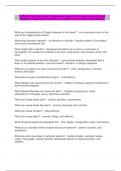NURS 612 Maryville Exam 2 | Questions & Answers (100 %Score) Latest Updated
2024/2025 Comprehensive Questions A+ Graded Answers | With Expert Solutions
What are characteristics of Paget's disease of the breast? - an eczematous rash on the
area of the nipple and/or areola.
What does jaundice indicate? - an elevation in bilirubin. Usually evident in the scelera
and mucus membranes first.
What might pallor indicate? - decreased circulation to an area or a decrease in
hemoglobin. It's usually first noticed on the face, conjunctiva, oral mucosa, and/or nail
beds.
What might redness of the skin indicate? - a generalized problem associated with a
fever or a localized problem, such as sunburn, infection, or allergic response.
What do you assess for when examining the skin? - color, temperature, moisture,
texture, and turgor.
What would cause increased skin turgor? - scleroderma.
What disease can cause bronze skin tones? - Addison's disease (adrenal insufficiency)
and hemochromatosis.
What disease/illnesses can cause tan skin? - chloasma (pregnancy), lupus,
scleroderma, ichthyosis, sprue, and tinea versicolor.
What can cause yellow skin? - uremia, jaundice, carotenemia
What can cause dusky blue skin? - arsenic poisoning and cyanosis.
What can cause red skin? - polycythemia.
What can cause pallor? - anemia, vitiligo, and albinism.
What should all lesions be assessed for? - size, shape, configuration, color, and texture.
What do you consider when multiple lesions are present? - pattern, location, and
distribution.
What are some examples of vesicular lesions? - herpes simplex, varicella, herpes
zoster, tinea pedis, contact dermitis, dyshidrosis (found on hands and feet), and
scabies.
, What are some examples of bullae (large blisters)? - erythema multiforme (includes
Stevens-Johnson syndrome), bullous impetigo, bullous tinea, and event contact
dermatitis.
What are some examples of pustular lesions? - acne vulgaris, acne rosacea, and
bacterial folliculitis.
Folliculitis is typically associated with staphylococci. What other microorganisms can
cause folliculitis? - Psuedomonas (associated with hot tubs), Candida, tinea barbae,
and herpes.
What are some examples of keratotic lesions? - warts, actinic keratoses, and corns and
calluses.
Describe keratotic lesions. - lesions are rough and generally raised. They contain a high
amount of keratin and they may appear scaly.
What are some examples of raised, skin-colored lesions? - basal cell carcinoma,
squamous cell carcinoma, epidermal inclusion cyst (epidermoid cyst), molluscum
contagiosum, and xanthomas (abnormal lipid metabolism).
What are some examples of white lesions? - pityriasis alba (white/lighter patches on
face in children), tinea versicolor, milia, and vitiligo.
What are some examples of brown lesions? - freckles, nevi, melanoma, seborrheic
keratosis, acanthosis nigricans, cafe au lait (may point to neurofibromatosis/ Fanconi
anemia), and congenital nevi/giant hairy pigmented nevus (potential for transition to
melanoma).
What are some examples of inflammatory or red lesions? - cherry hemangioma,
pyogenic granulomas (not caused by infection, stem from vascular proliferation),
furuncles (boils, when multiple called carbuncles and common in axilla or
groin/accompanied by lymphadenopathy), cellulitis, hidradenitis suppurativa, urticaria
(hives), erythema nodosum, psoriasis, lupus erythematosus, lichen planus (associated
with Hep C), secondary syphilis, tinea corporis, and pityriasis rosea.
Describe pityriasis rosea. - Is believed to be caused by a virus. Herald patch is similar to
tinea and typically located on the trunk. Several days later a more diffuse set of smaller
pink, salmon, or fawn-colored lesions appear. May be a Christmas tree distribution
because they follow tension lines.
What are some examples of eczematous lesions with excoriations? - atopic dermatitis,
dyshidrosis, stasis dermatitis, seborrheic dermatitis (e.g. cradle cap). and contact
dermatitis.




